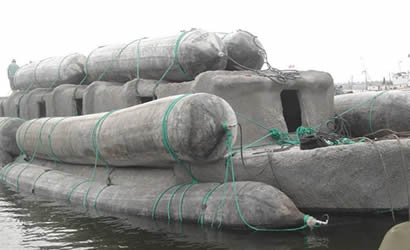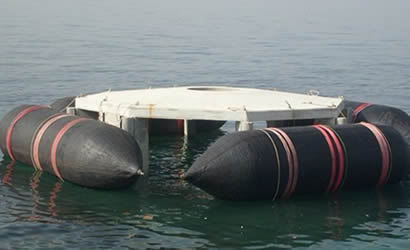Marine Salvage Airbags Features And Functions
Marine salvage airbags features and functions are different from ship launching airbags, but it has similar structures with them. Salvage airbags feature some optimal designs for salvage and flotation applications taking advantage of stiff and lightweight structures, lifting belts, and buckles. Rubber belts are usually used to secure airbags together and the bundles are easier. The safety valve is mounted at the end of the airbag, which is an ideal choice to automatically release internal pressure when using sea rescue airbags in the deep sea.
Due to the most robust aerodynamic mechanism, sea salvaging airbags are usually used as temporary transport equipment, or for other occasions, such as shipwreck salvage, pontoon, pier construction, etc. The lifting speed should usually be controlled at about 1 meter per minute to ensure that the airbag has sufficient time to discharge the expanded air in the overpressure valve.
Features of Marine Salvage Airbags:
- Not easy to be affected by wind and waves.
- Less demand of binding.
- Easy to meet the needs of buoyancy ranging from 100 tons to 2000 tons.
- Easy to transport and store while the airbags are deflated.
- Super-high tensile strength owing to its framework material – heavy-duty synthetic-tire-cord layers with breaking strength of more than 15,000 N/ 5cm.
- Excellent resistance against abrasion and scratch.
- Low maintenance.
- High flexibility and cost-effectiveness.
Functions of Marine Salvage Airbags:
- Alternatives to rigid pontoon
Marine salvage airbags with high buoyancy from 10 tons to 50 tons per piece are perfect for supporting docks, floating bridges, and other floating structures with insufficient buoyancy or shortage of lifting capacity from barge crane. At the same time, they are the best choice for where traditional rigid pontoons are not applicable such as rescuing some capsizing vessels. - Drain function
Vessel cabins can be filled with marine salvage airbags to drive water out and restore the buoyancy of vessels when airbags are inflated with air. Typically, the maximum pressure of the computer compartment and deck should be composed before the airbag is inserted into the cabin. Sometimes, reinforcement should be performed to ensure that the deck and the cab can withstand the pressure of marine salvage airbags. - Jack stranded & sunken vessels up
For stranded vessels with more than 200 tons, marine salvage airbags can be applied to jack them up and send them back to water without need to dredging the watercourse or using crane airbag. For sunken vessels, insert marine salvage airbags between the bottom and seabed of vessels, then fill them with air to increase buoyancy of sunken vessels and jack vessels up. - Caisson launching
In the freshwater season, insufficient water level makes ship launching and caisson launching impossible. Therefore, buoyancy tanks and bags are needed. Marine salvage airbags, not only can jack stranded or sunken vessels up, but also capable to provide a safe and smooth launch of vessels up to 5,000 tons or caissons up to 8,000 tons.
>>The Use of Ship Airbags Video
>>The distinction between ship launching and salvage airbags video
>>New applications of airbags for shipping in the marine field



